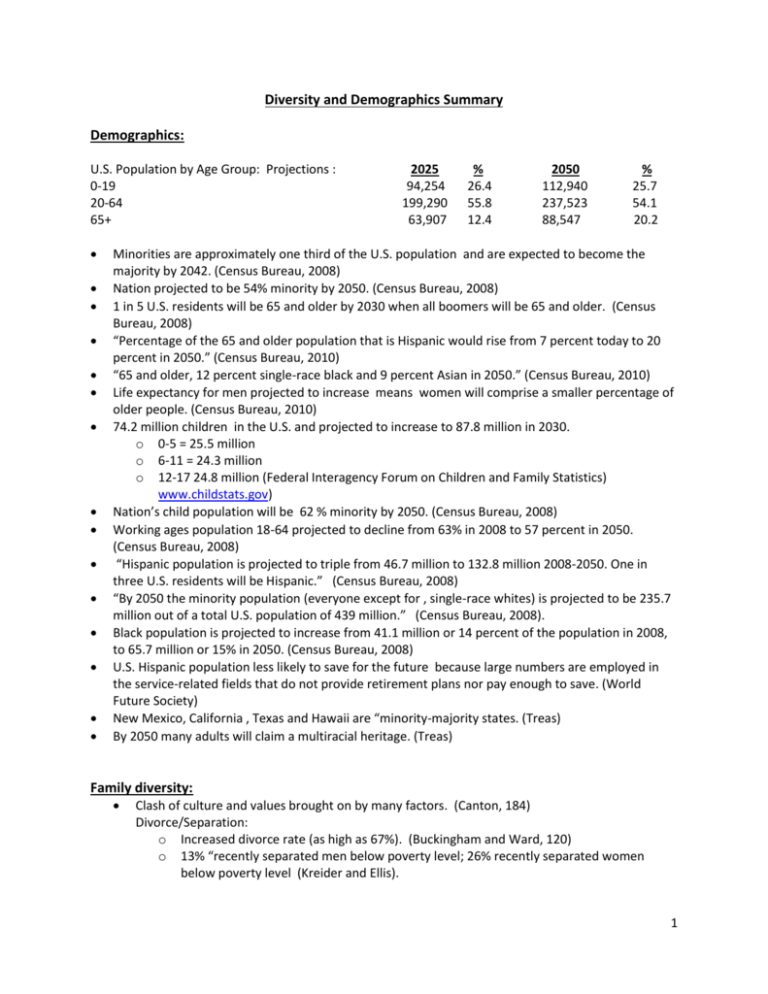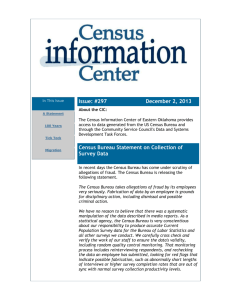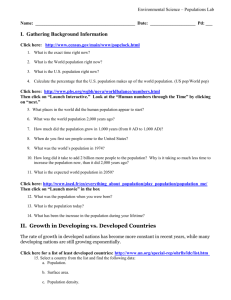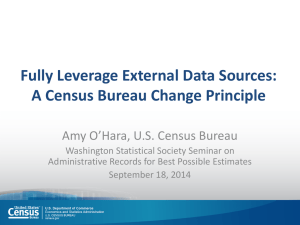Diversity and Demographics Summary
advertisement

Diversity and Demographics Summary Demographics: U.S. Population by Age Group: Projections : 0-19 20-64 65+ 2025 94,254 199,290 63,907 % 26.4 55.8 12.4 2050 112,940 237,523 88,547 % 25.7 54.1 20.2 Minorities are approximately one third of the U.S. population and are expected to become the majority by 2042. (Census Bureau, 2008) Nation projected to be 54% minority by 2050. (Census Bureau, 2008) 1 in 5 U.S. residents will be 65 and older by 2030 when all boomers will be 65 and older. (Census Bureau, 2008) “Percentage of the 65 and older population that is Hispanic would rise from 7 percent today to 20 percent in 2050.” (Census Bureau, 2010) “65 and older, 12 percent single-race black and 9 percent Asian in 2050.” (Census Bureau, 2010) Life expectancy for men projected to increase means women will comprise a smaller percentage of older people. (Census Bureau, 2010) 74.2 million children in the U.S. and projected to increase to 87.8 million in 2030. o 0-5 = 25.5 million o 6-11 = 24.3 million o 12-17 24.8 million (Federal Interagency Forum on Children and Family Statistics) www.childstats.gov) Nation’s child population will be 62 % minority by 2050. (Census Bureau, 2008) Working ages population 18-64 projected to decline from 63% in 2008 to 57 percent in 2050. (Census Bureau, 2008) “Hispanic population is projected to triple from 46.7 million to 132.8 million 2008-2050. One in three U.S. residents will be Hispanic.” (Census Bureau, 2008) “By 2050 the minority population (everyone except for , single-race whites) is projected to be 235.7 million out of a total U.S. population of 439 million.” (Census Bureau, 2008). Black population is projected to increase from 41.1 million or 14 percent of the population in 2008, to 65.7 million or 15% in 2050. (Census Bureau, 2008) U.S. Hispanic population less likely to save for the future because large numbers are employed in the service-related fields that do not provide retirement plans nor pay enough to save. (World Future Society) New Mexico, California , Texas and Hawaii are “minority-majority states. (Treas) By 2050 many adults will claim a multiracial heritage. (Treas) Family diversity: Clash of culture and values brought on by many factors. (Canton, 184) Divorce/Separation: o Increased divorce rate (as high as 67%). (Buckingham and Ward, 120) o 13% “recently separated men below poverty level; 26% recently separated women below poverty level (Kreider and Ellis). 1 o 26% recently divorced men (or someone in household) received noncash public assistance. o 50% recently divorced women (or someone in household) received noncash public assistance. o U.S. has higher marriage rates and higher divorce rates compared to other western nations. Interracial marriages (** survey data based on 39,000 homes) (Krieder and Ellis) o Asians have the highest proportion of interracial marriage, white and black lower. o Younger women have higher percentages of interracial marriages. o Divorce rate is higher for interracial couples. Millenials value parenthood over marriage. (Wang) Younger families/professionals moving to more convenient downtown areas – challenge to government is to make these communities more appealing. (Kemp) By 2036 social networks will have changed relationships and human interactions o People will maintain 500 social relationships. (Pincus) Aging – VA The population of Virginians age 60 and over will grow from 14.7 percent of the total population in 1990 to almost 25 percent by 2025 when there will be more than 2 million Virginians in this age group. (Virginia Department For the Aging) The number of Virginians age 85 and older will increase dramatically between 1990 and 2025 – five times faster than the state’s total population growth. (Virginia Department For the Aging) Virginia's older population is growing more racially and ethnically diverse, reflecting the growing racial and cultural diversity of the Commonwealth and the nation. (Virginia Department For the Aging) In 1990, older women outnumbered older men in Virginia by almost 42 percent. As a result of improving survival rates and increased life expectancies for older men, by 2025 older Virginian women are expected to outnumber older men by only 18 percent. (Virginia Department for the Aging) Aging – General Information: Life expectancy: people who survive to 65 can expect to live an average of 18.5 more years. (Federal Interagency Forum on Aging Related Statistics, 24) Death rates at older ages could decline. (Federal Interagency Forum on Aging Related Statistics) The elderly in poor health is projected to increase. (Administration on Aging) projected increase of moderate to severely disabled elderly to 22.6 million by 2040 – this is a 350% increase from 1986. (Administration on Aging). Larger need for nursing home care rather than home care at ages 85 and over. (Administration on Aging) Larger numbers of elders immigrating from other countries – the top three being Mexico, India and China. (Treas) Motherhood: Number of births in 1990 – 4.2 million; number of births in 2008 4.2 million (Taylor) Age: 1990: teens = 13% 2008 teens = 10% 1990: 35+ = 9% 2008 35+ = 14% 2 Marital Status: Education: 1990 28% 1990 41% 2008 41% 2006 54% with some college education 35+ 71% with some college education Fewer women in prime childbearing age (baby boomers now in their 40’s). (Taylor) Growing number of immigrants with a tendency toward higher birth rates. (Taylor) If trends continue there will be 142 million people added to the population from 2005-2050, and 50 million of these will be the children or grandchildren of new immigrants. (Taylor) Mental Health: Number of older adults with mental illness is expected to reach 15 million by 2030. (Hooyman) o Concern about social worker and psychiatry professionals being less diverse in racial and ethnic backgrounds than the older populations they serve. (Hooyman) o Concern about lack of specific training for geriatric mental health in the social work and psychiatric professions. (Hooyman) o Large percentage of older people seek care from their primary care physician for common mental disorders. (Hooyman) Approximately 11 percent of adolescents have a depressive disorder by age 18 according to the National Comorbidity Survey-Adolescent Supplement INCS-A. (National Institute of Mental Health) o Girls tend to experience more depression than boys. o Specific brain circuits involved in depression are being identified with advanced brain imaging techniques. (National Institute of Mental Health) o Telemedicine (service provided over the internet, by phone or satellite and perhaps other devices) and collaborative team-based care will help improve the quality of mental health for youth population (National Institute of Mental Health). Social Relations Long distance relationships become more popular as people expand search to find compatible person, not just person who is close in proximity. (Buckingham and Ward, 32) o Online dating standard practice (Buckingham and Ward, 119) o Continued increase in divorce rate and increase in number of blended families. (Buckingham and Ward, 119-120) Obesity: The estimated U.S. obesity prevalence has increased from 14.5% in 1967-1980 to 33.8% in 20072008 amongst adults age 20 and older. (Zahang) Estimated cost of obesity in the U.S. is approximately $147 billion. (Zahang) If the prevalence of obesity remains unchanged, per capita spending on health care for adults would rise 65% by 2020. (Zahang) Volunteering – Baby Boomers: Higher numbers of volunteers than previous generations: o higher education and school-aged children at home - research indicates those with children at home volunteer more. o Higher turnover of volunteers 3 o o Different volunteer interests from past generation: civic, education and youth services. Baby boomers have higher education levels than compared to older generations. (Corporation for National and Community Service) Sources Administration on Aging. http://www.aoa.gov/AoARoot/Aging_Statistics/future_growth/aging21/health.aspx Web Aug. 2011. Buckingham, Jane and Tiffany Ward. What’s Next: The Expert’s Guide-Predictions from 50 of America’s Most Compelling People. New York: Harper, 2008. Print. Canton, James. The Extreme Future: The Top Trends that will Reshape the World in the next 20 Years. New York: Plume, 2006. Print. Census Bureau. (2008). http://www.census.gov/newsroom/releases/archives/population/cb08123.html Web. June 2011. Census Bureau. (2010) http://www.census.gov/newsroom/releases/archives/aging_population/cb1072.html Web. June 2011 Corporation for National and Community Services. “ Keeping Baby Boomers Volunteering.” http://www.nationalservice.gov/pdf/07_0307_boomer_report.pdf Web. Dec. 2011. Federal Interagency Forum on Aging Related Statistics. “Older Americans 2010. Key Indicators of Well Being.” http://www.agingstats.gov/agingstatsdotnet/main_site/default.aspx Web: Dec. 2011. Federal Interagency Forum on Children and Family Statistics. (www.childstats.gov Web. Dec. 2011) Hooyman, NancyUnützer, Jürgen. "A Perilous Arc Of Supply And Demand: How Can America Meet The Multiplying Mental Health Care Needs Of An Aging Populace?." Generations 34.4 (2010): 36. MasterFILE Premier. Web. 4 Jan. 2012. Kemp, Roger L. “The “American Dream” Moves Downtown.” The Futurist. March-April 2011. Print. Kreider, Rose and Renee Ellis. “Number, Timing and duration Of Marriage and Divorce, 2009.” Census Bureau. http://www.census.gov/prod/2011pubs/p70-125.pdf Web. Dec. 2011 National Institute of Mental Health. “Depression in Children and Adolescents Fact Sheet. “ http://www.nimh.nih.gov/health/publications/depression-in-children-andadolescents/index.shtml Web. Jan. 2012 Taylor, Paul. Project Director. Pew Research Center. “The New Demography of American Motherhood.” 4 Web: Dec. 2011. http://pewsocialtrends.org/files/2010/10/754-new-demography-ofmotherhood.pdf Treas, Judith Carreon, Daisy. "Diversity And Our Common Future: Race, Ethnicity, And The Older American." Generations 34.3 (2010): 38. MasterFILE Premier. Web. 5 Jan. 2012. Wang, Wendy. “For Millenials Parenthood Trumps Marriage. Pew Research Center. http://www.pewsocialtrends.org/2011/03/09/for-millennials-parenthood-trumps-marriage/ Zahang, Xingyou et al. “Modeling Spatial Accessibility to Parks: A National Study.” International Journal of Health Geographics. 2011. Vol.10 Issue 31. Virginia Department For the Aging. Demographic Trends. http://www.vda.virginia.gov/demographic.asp. Web. Dec. 2011 World Future Society. Forecasts from Futuristic magazine. http://www.wfs.org/content/outlook-2011 5








